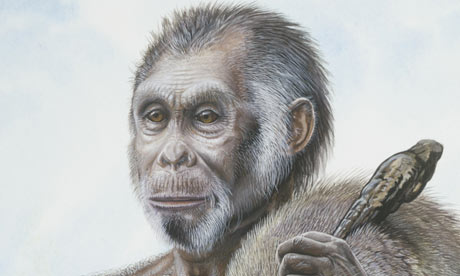
Researchers from Stony Brook University Medical Center in New York have confirmed that Homo floresiensis is a genuine ancient human species and not a descendant of healthy humans dwarfed by disease. Using statistical analysis on skeletal remains of a well-preserved female specimen, researchers determined the "hobbit" to be a distinct species and not a genetically flawed version of modern humans. Details of the study appear in the December issue of Significance, the magazine of the Royal Statistical Society, published by Wiley-Blackwell.
In 2003 Australian and Indonesian scientists discovered small-bodied, small-brained, hominin (human-like) fossils on the remote island of Flores in the Indonesian archipelago. This discovery of a new human species called Homo floresiensis has spawned much debate with some researchers claiming that the small creatures are really modern humans whose tiny head and brain are the result of a medical condition called microcephaly.
Researchers William Jungers, Ph.D., and Karen Baab, Ph.D. studied the skeletal remains of a female (LB1), nicknamed "Little Lady of Flores" or "Flo" to confirm the evolutionary path of the hobbit species. The specimen was remarkably complete and included skull, jaw, arms, legs, hands, and feet that provided researchers with integrated information from an individual fossil.
The cranial capacity of LB1 was just over 400 cm, making it more similar to the brains of a chimpanzee or bipedal "ape-men" of East and South Africa. The skull and jawbone features are much more primitive looking than any normal modern human. Statistical analysis of skull shapes show modern humans cluster together in one group, microcephalic humans in another and the hobbit along with ancient hominins in a third.
Due to the relative completeness of fossil remains for LB1, the scientists were able to reconstruct a reliable body design that was unlike any modern human. The thigh bone and shin bone of LB1 are much shorter than modern humans including Central African pygmies, South African KhoeSan (formerly known as 'bushmen") and "negrito" pygmies from the Andaman Islands and the Philippines. Some researchers speculate this could represent an evolutionary reversal correlated with "island dwarfing." "It is difficult to believe an evolutionary change would lead to less economical movement," said Dr. Jungers. "It makes little sense that this species re-evolved shorter thighs and legs because long hind limbs improve bipedal walking. We suspect that these are primitive retentions instead."
Further analysis of the remains using a regression equation developed by Dr. Jungers indicates that LB1 was approximately 106 cm tall (3 feet, 6 inches)—far smaller than the modern pygmies whose adults grow to less than 150 cm (4 feet, 11 inches). A scatterplot depicts LB1 far outside the range of Southeast Asian and African pygmies in both absolute height and body mass indices. "Attempts to dismiss the hobbits as pathological people have failed repeatedly because the medical diagnoses of dwarfing syndromes and microcephaly bear no resemblance to the unique anatomy of Homo floresiensis," noted Dr. Baab.

A painting of what researchers believe Homo floresiensis may have looked like. Illustration: Peter Schouten
It remains one of the greatest human fossil discoveries of all time. The bones of a race of tiny primitive people, who used stone tools to hunt pony-sized elephants and battle huge Komodo dragons, were discovered on the Indonesian island of Flores in 2004.
How a hobbit is rewriting the history of the human race:
The discovery of the bones of tiny primitive people on an Indonesian island six years ago stunned scientists. Now, further research suggests that the little apemen, not Homo erectus, were the first to leave Africa and colonise other parts of the world....
It remains one of the greatest human fossil discoveries of all time. The bones of a race of tiny primitive people, who used stone tools to hunt pony-sized elephants and battle huge Komodo dragons, were discovered on the Indonesian island of Flores in 2004....
The end result caused consternation. These remains came from a species that turned out to be only three feet tall and had the brain the size of an orange. Yet it used quite sophisticated stone tools. And that was a real puzzle. How on earth could such individuals have made complex implements and survived for aeons on this remote part of the Malay archipelago?....
That is odd enough. However, new evidence suggests the little folk of Flores may be even stranger in origin. According to a growing number of scientists, Homo floresiensis is probably a direct descendant of some of the first apemen to evolve on the African savannah three million years ago. These primitive hominids somehow travelled half a world from their probable birthplace in the Rift Valley to make their homes among the orangutans, giant turtles and rare birds of Indonesia before eventually reaching Flores.
